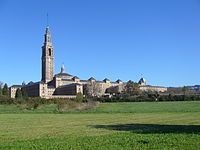Universidad Laboral de Gijón
| Universidad Laboral de Gijón | |
|---|---|
 |
|
| General information | |
| Architectural style | Neo-Herrerian |
| Address | Luis Moya Blanco, 261 33203 Gijón (Asturias) |
| Town or city | Gijón, Asturias |
| Country | Spain |
| Coordinates | 43°31′28.08″N 5°36′54.16″W / 43.5244667°N 5.6150444°W |
| Construction started | 1946 |
| Completed | 1955 |
| Renovated | 2001–2007 |
| Universidad Laboral de Gijón | |
|---|---|
| Location | Gijón, Spain |
| Area | 45.64 ha |
| Built | 1955 |
| Official name: Universidad Laboral de Gijón | |
| Type | Non-movable |
| Criteria | Monument |
| Designated | 19 May 2016 |
The Universidad Laboral de Gijón is located in Gijón (Asturias, Spain) specifically in the parish of Cabueñes.
Built between 1946 and 1955, it is the most important architectural work built in the 20th century in Asturias and is considered, with its 270,000 m2, the biggest building in Spain.
On 19 May 2016 the Universidad Laboral was declared Bien de Interés Cultural.
The building is built with its back facing Gijón. Luis Moya designed it based on the Parthenon, with the aim of surrounding the building before entering to enjoy its full magnificence.
The door is located in the main facade, an arch with a shaped tower. Above the arch is a shield with the eagle of Saint John and the yoke and arrows of the Catholic Monarchs with two angels holding it.
The courtyard is uncovered with an area of 150×150 m2. All of the building is structured around the courtyard.
The church is the most spectacular building in the Universidad Laboral. With a surface area of 807 m2, it is the biggest church with an elliptical floor in the world.
Outside, there is a figure of the Virgin of Covadonga with Corinthian columns sustaining the statues of St. Joseph, St. Peter, St. Paul and St. Ignatius. Above them all, St. James on horse with two angels sustains the Victory Cross, the coat of arms of Asturias.
The church has a 2,300-ton dome. The height between the floor and the highest point of the dome is 32 m. In the construction of the church about 450,000 bricks were used. The floor is made entirely of marble and the benches, for more than one thousand people, of a special wood from Equatorial Guinea. The original benches were cut exclusively for this church and each was made in one piece. Today, the benches are not in the church.
The church is unconsecrated and has no Catholic icon. It is currently used to host art exhibitions.
The theater has a Hellenic style facade and similar dimensions to the Parthenon. Above the central pediment there is a big coat of arms of Spain following the model of 1945.
...
Wikipedia
